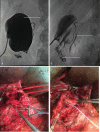A giant biliary cyst of Todani IA in a young woman: A case report
- PMID: 33466146
- PMCID: PMC7808493
- DOI: 10.1097/MD.0000000000024022
A giant biliary cyst of Todani IA in a young woman: A case report
Abstract
Rationale: Biliary cysts (BC) are rare dilatations of various parts of a biliary tract. They account for approximately 1% of all benign biliary diseases. Total cyst excision and Roux-Y hepaticojejunostomy is the treatment method of choice in most patients. In this paper, a novel surgical treatment with the use of internal biliary and pancreatic catheters was presented.
Patient concerns: A 21-years-old woman with a giant choledochal cyst of Todani IA type presenting with abdominal pain, nausea, fever and palpable abdominal mass. It had been previously drained as a misdiagnosed pancreatic cyst in another hospital.
Diagnosis: A very high amylase level (107140,0 U/l) in drain fluid was noted in laboratory tests. Endoscopic retrograde cholangiopancreatography revealed a biliary cyst located in the distal common bile duct and a pancreaticobiliary anomaly was suggested. A cholangiography per catheter inserted to the biliary cyst showed a large round contrast-filled cyst. A cholangiography following cyst decompression revealed a very long, tortuous bile duct entering the duodenum.
Interventions: Cholecystectomy, cyst resection, Roux-Y hepaticojejunostomy, and implantation of catheters into pancreatic and bile duct were performed. The postoperative course was uneventful and she was discharged on 12th day without any complications. Histopathology revealed a cyst wall partially lined with biliary-type and mucinous epithelium, with dysplasia ranging from low to high grade (biliary intraepithelial neoplasia, high grade), without invasion.
Outcomes: The biliary and pancreatic catheters were removed during endoscopic retrograde cholangiopancreatography 8 weeks following surgery without any complications. Fourteen months later, the patient reported good health.
Lessons: Diagnosis of the abdominal cyst should be very precise in order to avoid misdiagnosis and inadequate management. The early diagnosis and proper treatment of BC are needed in order to avoid serious complications. The cholangiocarcinoma is the most dangerous potential complication of BC due to dysplasia within the cyst wall as in our young female patient.
Copyright © 2021 the Author(s). Published by Wolters Kluwer Health, Inc.
Conflict of interest statement
The authors have no conflicts of interest to disclose.
Figures

References
-
- Madadi-Sanjani O, Wirth TC, Kuebler JF, et al. . Choledochal cyst and malignancy: a plea for lifelong follow-up. Eur J Pediatr Surg 2019;29:143–9. - PubMed
-
- Babbitt DP. Congenital choledochal cyst: new etiological concept based on anomalous relationships of the common bile duct and pancreatic bulb. Ann Radiol (Paris) 1969;12:231–40. - PubMed
Publication types
MeSH terms
LinkOut - more resources
Full Text Sources
Other Literature Sources

